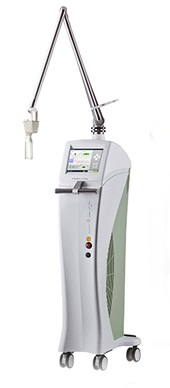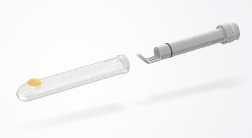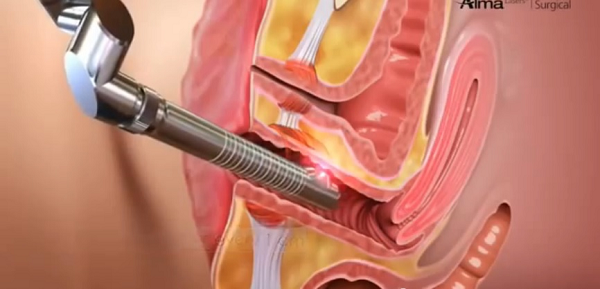FemiLift® is a fractional CO2 or carbon dioxide laser that is marketed to achieve vaginal tightening to relieve stress urinary incontinence. It is manufactured by Alma Lasers and distributed in the UK by ABC Lasers.

 FemiLift uses a fractional CO2 or carbon dioxide laser that is delivered via a probe which is inserted 6 to 8cms into the vaginal canal.
FemiLift uses a fractional CO2 or carbon dioxide laser that is delivered via a probe which is inserted 6 to 8cms into the vaginal canal.
The probe used to deliver the CO2 energy has a 360° rotation and is used with a single use, hygienic sleeve.
The FemiLift CO2 laser delivers energy approximately 0.5mm deep into the vaginal skin and creates tiny, white, ablated dots of damaged tissue on the mucosal tissue inside the vaginal canal. As with other fractional laser techniques used in aesthetics, the principle is that this stimulates the healing response in the non-ablated (non-damaged) tissue surrounding each micro-dot, and thus new collagen formation results and the thickness of the vaginal lining is improved.
The device has a history in gynaecological applications where CO2 lasers have been used by medical practitioners for several decades to remove genital warts and some cancers.

European CE Mark approved.
FDA approved since 2014 for the treatment of post-menopausal vaginal atrophy with dyspareunia (thinning of the vaginal lining that occurs when oestrogen decreases after menopause) which leaves many women unable to have intercourse due to dryness and pain on penetration.
Trained medical professionals only, with gynaecological knowledge and experience.
FemiLift is used for vaginal tightening to relieve stress urinary incontinence, increase vaginal lubrication and to improve sexual function and sexual satisfaction.
It is ideal for post-menopausal women as a relief for vaginal dryness.
Results are expected to last 18 months to 2 years for control of urinary incontinence. You may then require top-up treatment sessions to maintain the tightening and control.
The FemiLift treatment is considered to be minimally invasive with low downtime. Some women have noted that the treatment is more comfortable than having a smear test. You will feel some warmth during the delivery of the laser energy.
You can return to your normal activities almost immediately. You will be advised to avoid penetrative sexual intercourse or the insertion of tampons for approximately 5 days. You may also be advised to avoid strenuous exercise for a week.
Expect to experience some tenderness following treatment. Some women also experience a watery discharge or spotting for a day or so following treatment.
Although rare, there is a potential risk from the use of fractional carbon dioxide lasers of burns or necrosis (tissue death) if an area is over treated with the energy by mistake.
As long as you are generally healthy and don’t have any skin diseases or infections in the area treated, there are few medical reasons why you should not undergo this treatment.
It is advised not to have the procedure done whilst you have having your monthly period (menstruation) as the increase in blood in the area can impede the targeting and penetration of the laser into the tissue within the vaginal canal, making treatment less effective.
The treatment is also suitable for those with other vaginal concerns, including vaginal prolapse (depending on severity), endometriosis, pelvic relaxation and pelvic pain. There are no contraindications for FemiLift if you are taking the contraceptive pill, have a contraceptive implant or have previously had a hysterectomy.
If you are concerned that you have a sexually transmitted disease (STD) then this should be checked, diagnosed and treated, if required, before having a FemiLift treatment.
You may well be asked to provide results from a PAP smear test that you have had within the last 12 months, or have a smear test before treatment, if it has been several years since you were last tested. The results of this will be used to evaluate suitability for treatment in case of any abnormal results.
Pregnant women are advised to wait to until after the birth of their child before having treatment. FemiLift can be used approximately 3 months after childbirth, whilst breastfeeding, even if you want to have more children.
A course of up to 5 treatment sessions in recommended for FemiLift, spaced two to four weeks apart, particularly in the case of significant vaginal laxity.
Most women will notice a significant improvement after 2 or 3 treatment sessions. You may be advised to have a top-up treatment after one year to maintain your results.
The cost of FemiLift treatment depends on the practitioner treating and the number of treatment sessions required and can start from approximately £1,500 per treatment session, with a course of 2 or 3 treatments being over £3,000.
According to a manufacturer backed study from 2013 by Dr. Gabriel Femopase and Dr. Ignacio Lares in Argentina, which looked at 72 FemiLift patients, using the Female Sexual Function Index before, and 60 days post treatment - the results showed that 87% of patients experienced an increase in the overall score of tightening, level of improvement, satisfaction and vaginal lubrication, 10% of which was a mild improvement. Only 3% didn’t report any changes at all.
Do you have a question? Ask one of our experts NOW